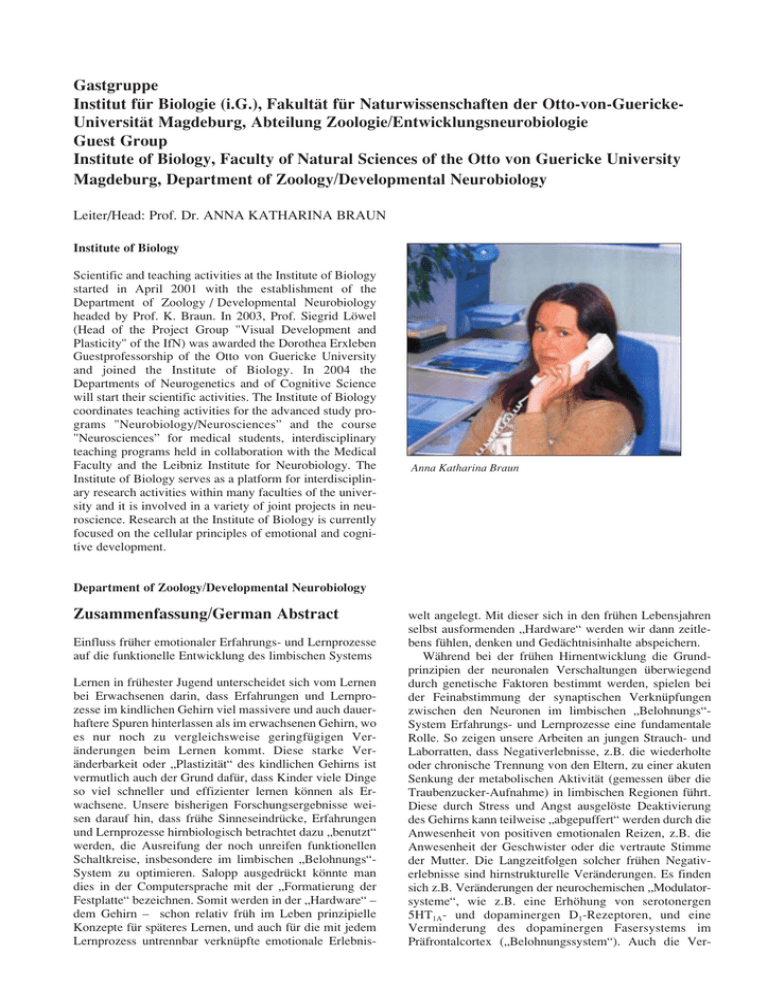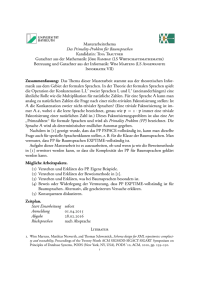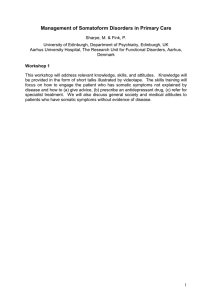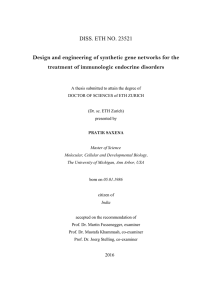Laout Jahresbericht IFN 02/03 - Leibniz Institut für Neurobiologie
Werbung

Gastgruppe Institut für Biologie (i.G.), Fakultät für Naturwissenschaften der Otto-von-GuerickeUniversität Magdeburg, Abteilung Zoologie/Entwicklungsneurobiologie Guest Group Institute of Biology, Faculty of Natural Sciences of the Otto von Guericke University Magdeburg, Department of Zoology/Developmental Neurobiology Leiter/Head: Prof. Dr. ANNA KATHARINA BRAUN Institute of Biology Scientific and teaching activities at the Institute of Biology started in April 2001 with the establishment of the Department of Zoology / Developmental Neurobiology headed by Prof. K. Braun. In 2003, Prof. Siegrid Löwel (Head of the Project Group "Visual Development and Plasticity" of the IfN) was awarded the Dorothea Erxleben Guestprofessorship of the Otto von Guericke University and joined the Institute of Biology. In 2004 the Departments of Neurogenetics and of Cognitive Science will start their scientific activities. The Institute of Biology coordinates teaching activities for the advanced study programs "Neurobiology/Neurosciences” and the course "Neurosciences” for medical students, interdisciplinary teaching programs held in collaboration with the Medical Faculty and the Leibniz Institute for Neurobiology. The Institute of Biology serves as a platform for interdisciplinary research activities within many faculties of the university and it is involved in a variety of joint projects in neuroscience. Research at the Institute of Biology is currently focused on the cellular principles of emotional and cognitive development. Anna Katharina Braun Department of Zoology/Developmental Neurobiology Zusammenfassung/German Abstract Einfluss früher emotionaler Erfahrungs- und Lernprozesse auf die funktionelle Entwicklung des limbischen Systems Lernen in frühester Jugend unterscheidet sich vom Lernen bei Erwachsenen darin, dass Erfahrungen und Lernprozesse im kindlichen Gehirn viel massivere und auch dauerhaftere Spuren hinterlassen als im erwachsenen Gehirn, wo es nur noch zu vergleichsweise geringfügigen Veränderungen beim Lernen kommt. Diese starke Veränderbarkeit oder „Plastizität“ des kindlichen Gehirns ist vermutlich auch der Grund dafür, dass Kinder viele Dinge so viel schneller und effizienter lernen können als Erwachsene. Unsere bisherigen Forschungsergebnisse weisen darauf hin, dass frühe Sinneseindrücke, Erfahrungen und Lernprozesse hirnbiologisch betrachtet dazu „benutzt“ werden, die Ausreifung der noch unreifen funktionellen Schaltkreise, insbesondere im limbischen „Belohnungs“System zu optimieren. Salopp ausgedrückt könnte man dies in der Computersprache mit der „Formatierung der Festplatte“ bezeichnen. Somit werden in der „Hardware“ – dem Gehirn – schon relativ früh im Leben prinzipielle Konzepte für späteres Lernen, und auch für die mit jedem Lernprozess untrennbar verknüpfte emotionale Erlebnis- welt angelegt. Mit dieser sich in den frühen Lebensjahren selbst ausformenden „Hardware“ werden wir dann zeitlebens fühlen, denken und Gedächtnisinhalte abspeichern. Während bei der frühen Hirnentwicklung die Grundprinzipien der neuronalen Verschaltungen überwiegend durch genetische Faktoren bestimmt werden, spielen bei der Feinabstimmung der synaptischen Verknüpfungen zwischen den Neuronen im limbischen „Belohnungs“System Erfahrungs- und Lernprozesse eine fundamentale Rolle. So zeigen unsere Arbeiten an jungen Strauch- und Laborratten, dass Negativerlebnisse, z.B. die wiederholte oder chronische Trennung von den Eltern, zu einer akuten Senkung der metabolischen Aktivität (gemessen über die Traubenzucker-Aufnahme) in limbischen Regionen führt. Diese durch Stress und Angst ausgelöste Deaktivierung des Gehirns kann teilweise „abgepuffert“ werden durch die Anwesenheit von positiven emotionalen Reizen, z.B. die Anwesenheit der Geschwister oder die vertraute Stimme der Mutter. Die Langzeitfolgen solcher frühen Negativerlebnisse sind hirnstrukturelle Veränderungen. Es finden sich z.B. Veränderungen der neurochemischen „Modulatorsysteme“, wie z.B. eine Erhöhung von serotonergen 5HT1A- und dopaminergen D1-Rezeptoren, und eine Verminderung des dopaminergen Fasersystems im Präfrontalcortex („Belohnungssystem“). Auch die Ver- 70 schaltungsmuster zwischen den Neuronen verändern sich, die früh „gestressten“ Tiere zeigen z.B. veränderte Dichten von Spinesynapsen im Präfrontalcortex, Hippocampus und in der lateralen Amygdala. Einige dieser synaptischen Veränderungen werden vermutlich über die Ausschüttung von Stresshormonen wie Cortisol bzw. Corticosteroiden vermittelt, d.h. im juvenilen Gehirn existiert eine enge Kopplung zwischen den durch Stress oder Angst ausgelösten endokrinen/hormonellen Reaktionen und der Ausreifung der Informationskanäle zwischen den Nervenzellen. Zukünftiges Ziel wird es sein, die erfahrungs- und lerninduzierten hormonellen Wechselwirkungen und die daran gekoppelten biochemischen und molekularen Reaktionskaskaden weiter aufzuschlüsseln, die in die Entwicklung der Nervenzellen des limbischen Systems eingreifen. Ihre genaue Kenntnis kann zur Beantwortung der Frage beitragen, inwieweit Verhaltens- und Lernstörungen und psychische Erkrankungen als hirnbiologische Funktionsstörungen betrachtet werden können. Darüber hinaus ergibt sich die Perspektive, das Grundlagenwissen zur erfahrungsgesteuerten Plastizität des Gehirns für den Bereich der Früherziehung zu nutzen, d.h. die Erkenntnisse aus der Lernforschung im Zusammenhang mit pädagogischen Konzepten zu betrachten. Research Report Juvenile emotional experience modulates the functional maturation of the limbic system Whereas the basic wiring diagram of the brain is genetically preprogrammed, its fine tuning throughout different phases of infancy, childhood, and adulthood are highly experience dependent. Normal brain development requires the precise interactions of environmental signals with genes and molecules that drive cellular differentiation and circuit formation. A critical regulator of these events is the dyadic interaction between the newborn and its parents, which controls the sensory and the socio-emotional environment of the developing individual and thereby interferes with brain development. The dyadic interaction between the newborn and its parents, carried by the reciprocal exhibition of parental/maternal behavior and newborn signaling, promotes physiological and immunological resilience, physical maturation and species-typical social and emotional development in the young individual. Such continued, adequate and well balanced stimulation contributes to the formation of a normally functioning limbic system. In contrast, disturbances or the interruption of the parent/motherinfant interactions may result in the formation of defective synaptic circuits, being responsible for the retarded or disturbed behavioral outcome which is observed in deprived individuals. Although on the behavioral level there is considerable evidence for rodents and primates including man that parental/maternal deprivation impairs the development of mental capacities and socio-emotional competence, systematic and multidisciplinary investigations are lacking to clarify causal relationships between behavioral pathology and abnormal brain cytoarchitecture and function. Thus, the aim of our research is to identify and characterize the cellular principles, the endocrine/hormonal, neurochemical Gastgruppe Institut für Biologie and molecular mechanisms which underlie learning- and experience-induced brain maturation and to evaluate the behavioral effects of socio-emotional deprivation and early life stress. Our experiments in different animal models unveiled the remarkable influence of the parent-infant contact on brain development and are in line with our working hypothesis that juvenile learning events and emotional experience have a strong impact on the functional maturation of the limbic pathway. The detailed knowledge of the neurobiology of such self-organizing plastic systems may begin to change our conceptual approaches to psychopathology and open new avenues of therapeutics for the major psychiatric illnesses that are critically dependent on such learning and memory mechanisms. Furthermore, the knowledge of the basic principles of learning- and memory-related neuronal plasticity may in the future be applied for innovative neuropaedagogic concepts for the preschool/elementary school levels. Changing the "wiring": cellular mechanisms of experience-induced synaptic plasticity C. Helmeke, J. Bock, W. Ovtscharoff jr, A. Abraham, R. Schnabel, U. Kreher, S. Becker Our studies in rodents (Octodon degus, Rattus rattus norwegicus) revealed that early traumatic emotional experience, such as stress during pregnancy, parental separation and chronic social isolation and early weaning, modifies the excitatory as well as monoaminergic modulatory synaptic input in cortical and subcortical limbic areas in a timedependent manner. A quantitative anatomical study in the rodent anterior cingulate cortex, hippocampus, and lateral amygdala revealed region-, cell-, and dendrite-specific changes of spine densities in 3-week-old Octodon degus after repeated parental separation (Poeggel et al., 2003). In parentally separated animals significantly higher spine densities were found in the cingulate cortex and in the hippocampal CA1 region, whereas reduced spine densities were observed on the granule cell dendrites in the dentate gyrus and on the apical dendrites in the medial nucleus of the lateral amygdala. Pharmacological blockade of 5HT1A receptors (1mg/kg) of the 5-HT1A antagonist Way-100, 635) during parental separation was able to prevent the stress-induced elevation of dendritic spines in the cingulate cortex. Interestingly, emotional and physical stress altersynaptic development in the anterior cingulate cortex in a different manner: Emotional stress elevates spine densities, whereas physical stress (daily saline injections) reduces spine densities. These results confirm that early socioemotional environment interferes with synaptic development in the prefrontal cortex and other limbic areas. Since the limbic system is critical for a variety of emotional behaviors and associative aspects of learning, such experience-induced morphological changes may lead to altered behavioral and cognitive capacities in later life. Collaborations: Prof. Gerd Poeggel, Zoologisches Institut Universität Leipzig; Prof. Micah, Leshem, Dept. Psychology, Haifa University, Prof. Marta Weinstock, Dept. Pharmacology, Hebrew University Medical Center, Jerusalem Funding: SFB 426 and the German-Israeli Science Foundation 71 Guest Group Institute of Biology Fig. 1: Different histological techniques for staining and 3D reconstruction of neurons and their synaptic connections. Left: Camillo Golgi´s "reazione nera" (1873), the traditional (and still unbeatable!) impregnation method for neurons, dendrites and postsynaptic dendritic spines. Top right: Dendrite labelled by injection of the fluorescent dye "Lucifer Yellow". In this 3D reconstruction from serial confocal laserscan image stacks the various shapes and sizes of postsynaptic dendritic spines can be particularly appreciated. Bottom right: Computer system, with which dendrites and spines can be automatically traced, and from which their volumes, surface and shape factors can be calculated. Fine-tuning of information channels: quantitative ultrastructural synaptic changes induced by early experience W. Ovtscharoff jr, R. Schnabel, U. Kreher In order to identify changes of ultrastructural parameters in relation to early experience we developed techniques for the three dimensional reconstruction of dendrites and spines from confocal laserscan image stacks and from ultrathin sections, in which synaptic parameters such as the surface, volume, curvatures, shape of the PSD etc can be measured. An indicator for experience induced changes of synaptic efficacy may be alterations of synaptic shape. The analysis of fine morphological parameters of dendritic spines was analysed on the basal dendrites of Lucifer Yellow-injected layer III pyramidal neurons in the anterior cingulate cortex of parentally deprived 45 days-old degus in comparison with age-matched socially undisturbed control pups. The 3D measurements of spines were performed in image stacks produced by a confocal laser scanning microscope applying a newly developed image analysis software (Herzog et al., SPIE 2984, 146-158, 1997). Although the spine volumes remained unchanged, a significant reduction of spine length, accompanied by a significant increase of mean spine diameters was observed in the parentally deprived animals. These overall effects were due to a reduction of spine length on dendritic branch 2 and 4, and a significant increase of spine diameter on branch 3. This is the first evidence that the disturbance of the parent-child contact during an early postnatal phase results in lasting changes of distinct shape parameters of presumed excitatory spine synapses, which most likely reflect an experiencerelated fine-tuning of synaptic strength within limbic cortical circuits. Collaborations: Prof. Dr. B. Michaelis, Institut für Elektronik, Signalverarbeitung und Kommunikationstechnik, Otto-von-Guericke-Universität Magdeburg Funding: VW-Stiftung Putting the brakes on excitation: early life time experience modulates inhibition in the limbic anterior cingulate cortex C. Helmeke, K. Becker, P. Kremz In addition to changes of excitatory spine synapses after early stress exposure we found changes in the GABAergic inhibitory interneurons, characterized by their content of either Ca2+-binding protein parvalbumin (PV), calbindin-D 28K (CaBP-D 28k) and calretinin (CaR). At the age of 45 days (puberty) lower densities of CaBP-D28K-immunoreactive cells were found in the anterior cingulate and in the precentral medial areas of the medial prefrontal cortex of deprived animals compared to controls. No differences were observed for the other two GABAergic subpopula- 72 Gastgruppe Institut für Biologie Fig 2: Electron microscopic reconstruction of identified neurons connections in in vitro hippocampal synaptic networks. A: Single ultrathin (90 nm) section of a cultured hippocampal neuron (large arrow), transfected with "Green fluorescent protein” (GFP), and immunostained with DAB and embedded for EM. Small arrows point to dendritic segments. B: Cell from A shown as 3D reconstruction from serial ultrathin sections, small arrows point to the same dendritic segmentsas shown in A. C: Higher magnification of a dendrite with postsynaptic spines (asterisks) and presynaptic terminals (triangles) that innervate spines or the dendritic shaft. D: Dendrite from C shown as 3D reconstruction from serial ultrathin sections, asterisks and triangles label identical structures as seen in C. tions. At the age of 90 days (adulthood) significantly higher densities of PV-immunoreactive cells were found in the anterior cingulate and in the precentral medial cortices of deprived animals, whereas the density of CaBP-D28Kimmunoreactive and of CaR-positive neurons were unchanged at this age. The altered numbers of CaBP-D 28k- and PV-immunoreactive inhibitory interneurons in the prefrontal cortex may counterbalance the excitability of the principal neurons, caused by their elevated spine densities. Collaborations: Prof. Dr. B. Michaelis, Institut für Elektronik, Signalverarbeitung und Kommunikationstechnik, Otto-von-Guericke-Universität Magdeburg; Prof. T. Voigt, Abteilung für Entwicklungsphysiologie, Medizinische Fakultät Otto-von-Guericke-Universität; Prof. A. Krost, Abt. Halbleiterepitaxie, OvGU Magdeburg Funding: LSA Fragile X mental retardation: Synaptic, neurochemical and metabolic dysfunctions in a genetic mouse model K. Braun, U. Kreher, M. Gruss, J. Bock To study the mechanisms underlying the formation of spines, their morphology and function under controlled conditions we used a model system for an inherited mental disorder, the fragile X mental retardation syndrome. FragileX, the main cause of inherited human mental retardation is associated with the absence of a recently identified FragileX mental retardation protein (FMRP), which was suggested to be involved in spine formation, elimination and stabilization during brain maturation. Biochemical studies provided the first evidence that the lack of FMRP expression in FMRP knockout mice is accompanied by agedependent, region-specific alterations in neurotransmission. Mice, which lack this protein due to a knockout (FMR1-/-) mutation, display altered levels of amino acids, monoamines and their metabolites (Gruss et al. 2003, Gruss and Guest Group Institute of Biology Braun, 2004). Significant region-specific differences of basal neurotransmitter and metabolite levels were found between wildtype and Fmr1 knockout animals, predominantly in juveniles (postnatal days 28 to 31) and less in adults. In juvenile knockout mice, aspartate and taurine were especially increased in cortical regions, striatum, hippocampus, cerebellum, and brainstem, and an altered balance between excitatory and inhibitory amino acids was found in the caudal cortex, hippocampus, and brainstem. The neurochemical alterations are paralleled by (and causally linked to?) structural and functional differences in the FMR1-/- mouse (Braun and Segal 2000, Cerebral Cortex 10,1045; Segal et al., 2003). The comparison of dendritic morphology of 2-week-old cultured neurons, taken from postnatal day 1 fragile X mental retardation gene1 knock out (FMR1-/-) mice hippocampus with cells taken from wild type mice revealed under control conditions that the FMR1-/- neurons displayed significantly lower spine densities compared to wild type neurons. Pharmacological stimulation of electrical activity, induced by bicuculline, caused a reduction in dendritic spine density in both the FMR1-/- and the wild type cells. In both groups, bicuculline induced a significant shrinkage of spines that were occupied by one or more synaptophysinimmunoreactive presynaptic terminals. The concentration of FMR1 in the wild type cultures was not affected by bicuculline treatment. These experiments indicate that FMR1 is not likely to be an essential factor in activitymodulated morphological plasticity of dendritic spines in cultured hippocampal neurons. Collaborations: Prof. M. Segal, The Weizmann Institute, Rehovot, Israel Funding: FRAXA Foundation and VW-Stiftung Publications of the Department Peer-reviewed original publications 2002 Metzger M, Jiang S, Braun K (2002) A quantitative immuno-electron microscopic study of dopamine terminals in forebrain regions of the domestic chick involved in filial imprinting. Neuroscience 111, 611-623 Metzger M, Toledo C, and Braun K (2002) Serotonergic innervation of the telencephalon in the domestic chick. Brain Res. Bull. 57, 547-551 2003 Braun K, Kremz P, Wetzel W, Wagner T, Poeggel G (2003) Influence of parental deprivation on the behavioral development in Octodon degus: Modulation by maternal vocalizations. Dev Psychobiol 42, 237-245 Poeggel G, Nowicki L, Braun K (2003) Early social deprivation alters monoaminergic afferents in the orbital prefrontal cortex of Octodon degus. Neuroscience 116, 617-620 73 Segal M, Kreher U, Greenberger V, Braun K (2003) Is Fragile X Mental Retardation Protein involved in activityinduced plasticity of dendritic spines? Brain Res. 972/12, 9-15 Ziabreva, I, Schnabel R, Poeggel G, Braun K (2003) Mother’s voice "buffers" separation-induced receptor changes in the prefrontal cortex of Octodon degus. Neuroscience 119, 433-441 Ziabreva, I, Poeggel G, Schnabel R, Braun K (2003) Separation-induced receptor changes in the hippocampus and amygdala of Octodon degus: Influence of maternal vocalizations. J. Neurosci. 23(12), 5329-5336 Dahlem Y, Dahlem M, Mair T, Braun K, Müller SC (2003) Extracellular potassium alters frequency and profile of retinal spreading depression waves. Exp Brain Res. 152, 221-228 Gruss M, Bock J, Braun K (2003) Haloperidol impairs auditory filial imprinting and modulates monoaminergic neurotransmission in an imprinting-relevant forebrain area of the domestic chick. J. Neurochem. 87, 686-696 Poeggel, G, Helmeke C, Abraham A, Schwabe T, Friedrich P, Braun, K (2003) Juvenile emotional experience alters synaptic composition in the rodent prefrontal cortex, hippocampus and lateral amygdala. Proc. Natl. Acad. Sci. USA 100, 16137-42 2004 / In press Gruss M, Braun K (2004) Age- and region-specific imbalances of basal amino acids and monoamine metabolism in limbic regions of female Fmr1 knock out mice. Neurochem. Int. (in press) Book chapters and other publications 2002 Braun K, Bock J, Gruss M, Helmeke C, Ovtscharoff jr W, Schnabel R, Ziabreva I, Poeggel G (2002) Frühe emotionale Erfahrungen und ihre Relevanz für die Entstehung und Therapie psychischer Erkrankungen. In: Strauss B, Buchheim A, Kächele H (Hrsg.) "Klinische Bindungsforschung–Theorien-Methoden-Ergebnisse", Schattauer Verlag für Medizin und Naturwissenschaften, Stuttgart Bock J, Braun K (2002) Juvenile emotions modulate the functional maturation of the brain: animal studies and their possible relevance for psychotherapy/ Frühkindliche Emotionen steuern die funktionelle Reifung des Gehirns: tierexperimentelle Befunde und ihre mögliche Relevanz für die Psychotherapie. Psychotherapie 7 (2), 190-194 2003 Braun K, Bock J (2003) Die Narben der Kindheit. Gehirn&Geist, 1/2003 Spektrum der Wissenschaften, S. 50-53 Bock, J, Helmeke, C, Ovtscharoff jr W, Gruss M, Braun K (2003) Frühkindliche emotionale Erfahrungen beeinflussen die funktionelle Entwicklung des Gehirns. Neuroforum 2/03, 51-57 Gruss M, Segal M, Braun K (2003) Das Fragile XSyndrom als Herausforderung für die Neurowissenschaften. FRAX-Info, 11 1/2003, 2-5 Braun K (2003) Wie Gefühle unser Gehirn verändern. Oder: Was Hänschen nicht lernt, lernt Hans nimmermehr? Forum Loccum Nr. 4, 7-11 74 Abstracts (selection) 2002 Helmeke, C, Ovtscharoff jr. W, Poeggel G, Braun K (2002) Lack of paternal care reduces spine density in the limbic cortex. Soc. Neurosci. 32, p59, 130.4 Ovtscharoff Jr. W, Helmeke C, Braun K (2002) Does paternal care affect the development of the prefrontal cortex? Developmental Psychobiology. Volume 41. Number 3. p318 Schnabel, R, Herzog, A, Michaelis, B, Braun, K (2002) Parental deprivation induces changes of distinct shape parameters of dendritic spines in the anterior cingulate cortex of Octodon degus. Soc. Neurosci. 32, p59. 130.5 2003 Gruss M, Westphal S, Luley C, Braun K (2003) Consequences of maternal separation during different stages of early development on HPA axis activity in three week old rats. Proc. of the 29th Göttingen Neurobiol. Conf., 151 Abraham A, Gruss M, Bock J, Braun AK (2003) Early parental separation induces more frequent play fighting but less seriouos fighting in degus (Octodon degus). Soc. Neurosci. 21/2, 481.6 Becker, K, Bock, J, Braun, K (2003) Changes of parental behavior after acute and repeated separation from the offspring in the precocious species Octodon degus. Proc. of the 29th Göttingen Neurobiol. Conf., 652 Helmeke, C, Abraham, A, Braun, K (2003) Differential effect of emotional and physical stress on cortical dendritic spine development and possible role of 5-HT1Areceptor blockade. Soc. Neurosci. 33, p22, 809.14 Braun, K, Bock, J (2003) Early traumatic experience alters metabolic brain activity in thalamic, hypothalamic and prefrontal cortical brain areas of Octodon degus. Soc. Neurosci. 33, p22, 376.2 Theses Diploma Theses Dipl. Biol. Tina Schwabe: Der Einfluß frühkindlicher sozio-emotionaler Erfahrungen auf die Morphologie von Neuronen im Hippocampus der Strauchratte (Octodon degus). Juni 2002, Universität Leipzig Dipl. Biol. Patricia Friedrich: Morphologische Veränderungen pyramidaler Neurone des lateralen amygdaloiden Kerns in Abhängigkeit von frühkindlichen emotionalen Erfahrungen bei der Strauchratte (Octodon degus). Juli 2002, Universität Leipzig Dipl. Psychol. Katja Becker: Einfluß von wiederholter und chronischer Elterndeprivation auf die Entwicklung emotionaler Verhaltensweisen bei heranwachsenden Strauchratten (Octodon degus): ein neues Tiermodell für Bindungs- und Aufmerksamkeitsstörungen? 2003, Fachbereich Psychologie, Universität Jena Ph.D. Theses Dipl.-Med. Ovtscharoff, Wladimir jun. (2002): The influence of early postnatal social deprivation on the establishment of synaptic composition in limbic cortices: quantitative electronmicroscopic studies in Octodon degus. Medizinische Fakultät der Otto-von-GuerickeUniversität Magdeburg Gastgruppe Institut für Biologie Helmeke, Carina (2003): Einfluss frühkindlicher Sozialerfahrung auf die funktionelle Reifung des limbischen Systems der Strauchratte (Octodon degus). Fakultät für Naturwissenschaften, Institut für Biologie der Otto-von-Guericke-Universität Magdeburg Structure of the Department Head Prof. Dr. Anna Katharina Braun Scientific Staff and Postdoctoral Fellows Dr. Michael Gruß Dr. Jörg Bock Dr. Reinhild Schnabel Dr. Wladimir Ovtscharoff Dr. Carina Helmeke Doctoral and Diploma Students Andreas Abraham Stoyan Stoyanov (since 06/2003) Meena Sriti Murmu (since 06/2003) Stefanie Zehle (since 04/2003) Grzegorz Jezierski (since 01/2003) Katja Becker Rowena Antemano (since 10/2003) Technicians Petra Kremz Ute Kreher Susann Becker Secretary Heike Corodonnoff-Reinhardt (since 12/2002)











